 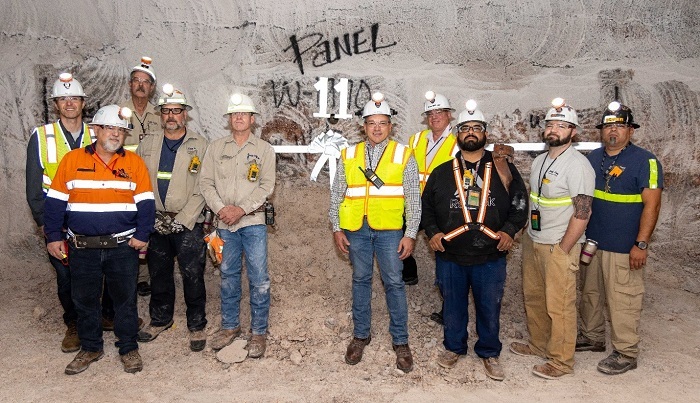 Waste Isolation Pilot Plant team members commemorate the first “cut” into Panel 11, the underground’s future waste disposal panel. Pictured from left: Ryan Flynn, Salado Isolation Mining Contractors (SIMCO) vice president and environment, safety and health manager; Mike Marksberry, SIMCO vice president and mining and underground operations manager; Craig Heine; Scott Reiner; Randy Wilson; Ken Harrawood, SIMCO president and program manager; Mark Bollinger, EM Carlsbad Field Office manager; Juan Cruz; Joseph Garrett; and Orlando Franco.
Renewed state operating permit enables crews to start work
CARLSBAD, N.M. — Just before the new year, there was quite the ribbon-cutting at EM’s Waste Isolation Pilot Plant (WIPP).
At the event, the spinning teeth of a multi-ton mechanical mining machine clawed through the ceremonial ribbon and began cutting a new disposal panel out of a 250-million-year-old layer of salt beneath the New Mexico desert.
It’s the first time in a decade that crews have started mining a new disposal panel at the nation’s only deep geologic waste repository for defense-related transuranic waste.
“The successful start to mining Panel 11 was a great demonstration of how open dialogue and communication with our regulators and stakeholders, along with the support of the field office team, can help mission success,” said Michael Gerle, environmental regulatory compliance director for EM’s Carlsbad Field Office, which oversees WIPP.
The new Panel 11 is the first of two waste emplacement panels approved earlier this year by the New Mexico Environment Department as part of a 10-year extension of WIPP’s operating permit. The new panel does not represent an increase in the scope for WIPP; the waste to be emplaced in Panel 11 is within original congressional volume limits established for the waste repository.
The creation of new panels allows safe and compliant emplacement of waste to continue from generator sites throughout the United States, supporting DOE’s environmental cleanup and national security missions.
"We are excited to begin mining WIPP’s newest panel,” said Mike Marksberry, a vice president and mining and underground operations manager with Salado Isolation Mining Contractors, EM’s management and operations contractor for WIPP. “Mining a disposal panel is a huge team effort involving our engineers, geologists, environmental staff, skilled mining crews and many support organizations.”
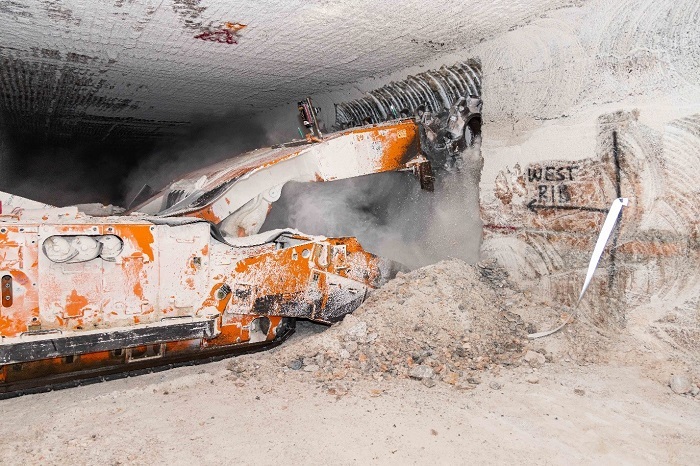 Approximately 2,150 feet underground, a mammoth-sized continuous miner machine cuts into salt rock, the beginning phase of what will become Panel 11, one of the Waste Isolation Pilot Plant’s next waste disposal panels.
The process of mining a panel
Located 26 miles southeast of Carlsbad, WIPP permanently isolates defense-generated transuranic waste 2,150 feet underground in panels mined out of an ancient salt formation. The facility has been disposing of transuranic waste since 1999.
Approximately 120,000 tons of salt rock is mined to create a panel, which consists of seven rooms. Each room measures 300 feet long by 33 feet wide by 14 feet high. It takes about two years to cut and outfit a panel.
Workers are currently emplacing waste into WIPP Panel 8. Panel 8’s first room, Room 7, has been filled and emplacement activities have moved to Room 6.
Panel 11 is connected to the rest of the WIPP facility by new pathways that stretch nearly half a mile from the existing mine to the west, connecting not only the new panels but a new air intake shaft key to increased ventilation in the WIPP underground.
Mining crews use a mammoth-sized, highly efficient continuous miner that cuts into the salt rock with a rotating drum, which can be elevated. Standing behind this cutting head, an operator remotely controls the machine, which has the capacity to generate 10 tons of salt per minute. Gathering arms move the salt onto a belt that carries it to a truck for use elsewhere in the underground or to a hoist that carries the salt from 2,150 feet underground to a salt tailings pile on the surface.
Mining at WIPP is timed so that a panel is only ready when it is needed for waste emplacement. This is because the natural movement of salt causes mined openings to close. In fact, panels are mined slightly larger than the desired size to account for this closure. This is the salt rock behavior that will eventually permanently encapsulate the waste.
-Contributor: Roy Neese
 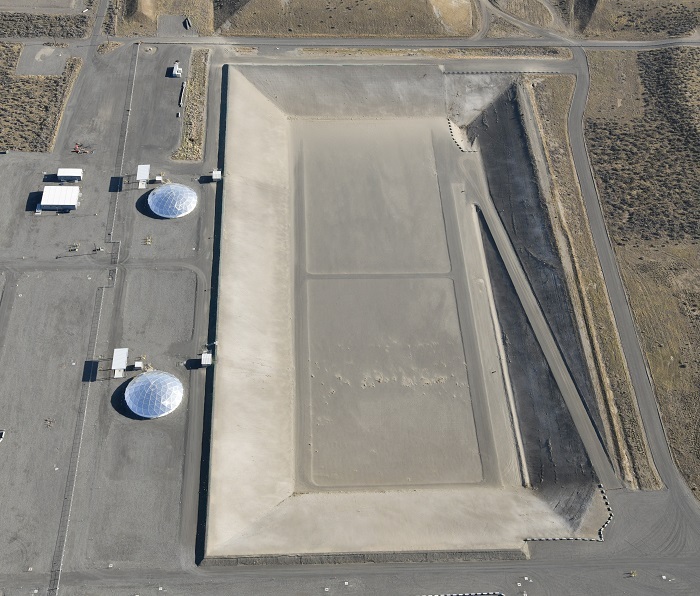 The Hanford Site’s Integrated Disposal Facility consists of two expandable disposal cells with a total disposal capacity of nearly 1.2 million cubic yards. The engineered landfill allows for safe disposal of vitrified, or immobilized in glass, low-activity waste from Hanford’s Waste Treatment and Immobilization Plant.
RICHLAND, Wash. — Crews with EM Richland Operations Office contractor Central Plateau Cleanup Company (CPCCo) recently completed construction of the Integrated Disposal Facility (IDF), a key component of the Direct-Feed Low-Activity Waste Program to treat the Hanford Site’s tank waste.
The IDF is an engineered landfill that will allow for safe disposal of vitrified, or immobilized in glass, low-activity waste from Hanford’s Waste Treatment and Immobilization Plant when it begins operations.
“Wrapping up construction at IDF is another important step toward beginning to treat tank waste, a top Hanford Site priority,” said Gary Pyles, EM Richland Operations Office project engineer.
The IDF consists of two expandable disposal cells totaling 1,345 feet wide, 2,151 feet long and 42 feet deep, with a waste disposal capacity of nearly 1.2 million cubic yards.
To protect groundwater under IDF, the disposal cells are lined and outfitted with equipment to collect water from rain, snowmelt and dust suppression — known as leachate — that filters through the landfill. Two 400,000-gallon storage tanks at the facility hold the leachate until it is sent to an onsite facility and treated to remove contaminants.
“Our experienced team is excited about the opportunity to contribute to the tank waste treatment mission and looks forward to the successful transition to operations,” said CPCCo Waste Projects & Operations Director Andy Drom.
The IDF is scheduled to receive its first containers of vitrified waste for disposal in 2025.
 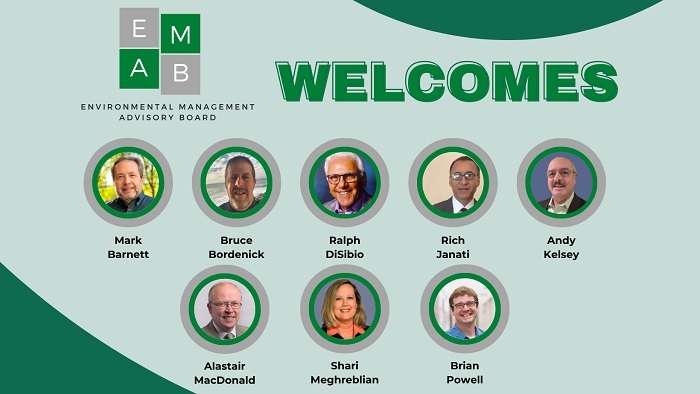
The Environmental Management Advisory Board (EMAB) recently welcomed eight new members who bring valuable perspectives and diverse experience to the board.
“We are thrilled to have eight new members join EMAB, including our first international member,” said Joceline Nahigian, director of the EM Office of Intergovernmental and Stakeholder Programs. “EM will benefit greatly from their expertise and experience, and we look forward to working with EMAB to advance our cleanup mission.”
The new EMAB members are:
- Mark Barnett, a professor of environmental engineering at Auburn University with over 30 years of environmental science and engineering experience.
- Bruce Bordenick, a senior engineer at SC&A Inc., who retired from the U.S. Navy after more than 30 years with experience in nuclear operations and safety.
- Ralph DiSibio, a former president of Washington Group International and former CEO and chair of Kurion Inc.
- Rich Janati, administrator of the Appalachian States Low-Level Radioactive Waste Compact Commission, serving the Pennsylvania Department of Environmental Protection.
- Andy Kelsey, a former vice president for business development for Bechtel, focused on nuclear cleanup at many DOE sites.
- Alastair MacDonald, vice president of decommissioning and waste management for Atomic Energy of Canada Limited, with over 35 years of experience in the nuclear and engineering services industry.
- Shari Meghreblian, a senior manager in Ernst & Young’s government and public service sector and a former commissioner of the Tennessee Department of Environment and Conservation.
- Brian Powell, a professor of nuclear environmental engineering and science at Clemson University, whose research focuses on the treatment and storage of radioactive waste.
The board's membership reflects a broad range of diverse perspectives, demographics and professional and academic experience. Appointed by the U.S. Energy Secretary, individuals serve as special government employees or representatives of specific interests and entities. Members serve two-year terms, which may be renewed by EM. The full biographies of EMAB’s 21 members can be found on the EMAB website.
EMAB operates under the Federal Advisory Committee Act and provides the EM Assistant Secretary with independent and strategic management advice, information and recommendations on corporate EM issues relating to accelerated site cleanup and risk reduction. EMAB has played an important role in guiding EM activities and has provided 237 recommendations since it was first chartered in 1992.
Those interested in joining EMAB may submit their resume to Kelly.Snyder@em.doe.gov to be considered for future membership vacancies.
-Contributor: Alyssa Petit

OAK RIDGE, Tenn. — EM recently announced the selection of Laura Wilkerson as chief engineer for the Oak Ridge Office of Environmental Management (OREM) and the reassignment of Erik Olds from EM’s communications director to OREM’s deputy manager.
As a recognized leader and technical expert, Wilkerson will focus on the most complex, crosscutting engineering challenges facing the Oak Ridge environmental cleanup program.
She has more than 30 years of experience directing and managing technical programs and projects across major DOE programs, including a long history with the environmental cleanup program. Wilkerson has served in a variety of positions for OREM, including acting manager, deputy manager, division director for planning and execution, and portfolio federal project director for cleanup and waste management activities at Oak Ridge National Laboratory (ORNL) and the Y-12 National Security Complex.
“We are excited to announce these critical OREM leadership positions,” said OREM Manager Jay Mullis. “As we continue to ramp up our environmental cleanup activities at ORNL and Y-12, Laura will use her extensive experience and in-depth knowledge about both of those sites to help us find solutions to some of our biggest technical challenges.”
 |
|
Laura Wilkerson was selected as the Oak Ridge Office of Environmental Management chief engineer to lead efforts to identify solutions for complex engineering challenges facing environmental cleanup projects. |
Olds will oversee day-to-day operations of OREM’s environmental cleanup and stewardship mission and other activities.
He brings extensive headquarters and field leadership, project and program management and policy experience to his new role. Olds has worked for DOE for more than 31 years and has served in a variety of assignments, including EM acting chief of staff, deputy project integration manager for the multi-billion dollar Direct-Feed Low-Activity Waste system at the Hanford Site, and chief of staff for both the Richland Operations Office and Office of River Protection at Hanford.
Prior to his leadership roles at Hanford and EM headquarters, Olds served at the Yucca Mountain Project in Nevada for the defunct Office of Civilian Radioactive Waste Management. He holds a bachelor’s degree in public relations and a master’s degree in communications studies from the University of Nevada, Las Vegas.
Erik Olds will serve as the Oak Ridge Office of Environmental Management deputy manager after leading communications for EM in Washington, D.C. |
|
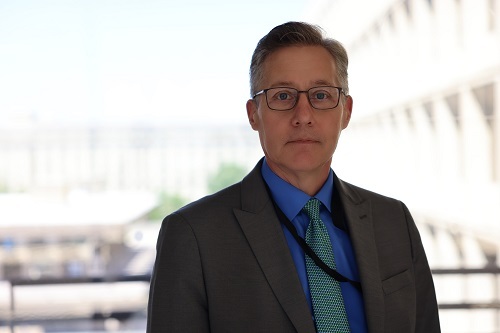 |
“The opportunity to add Erik to the OREM leadership team and promote Laura to chief engineer allows us to increase our focus on strengthening our organization as we continue to set the standard for cleanup across the EM complex,” Mullis said.
DOE’s Oak Ridge Reservation occupies more than 32,000 acres within Anderson and Roane counties in East Tennessee. OREM has cleanup responsibilities across the reservation, and its efforts are removing risks and hazards, enhancing safety, opening land for redevelopment, and enabling important science and energy research and national security missions at ORNL and Y-12.
 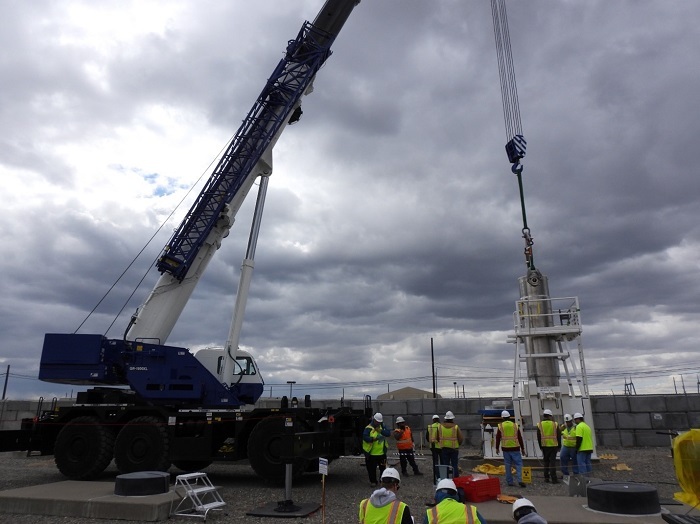 EM crews place a transfer cask over a first-generation vault for a Peach Bottom Atomic Power Station spent nuclear fuel basket at the Idaho Nuclear Technology and Engineering Center at the Idaho National Laboratory Site.
IDAHO FALLS, Idaho — EM crews at the Idaho National Laboratory (INL) Site continue to transfer spent nuclear fuel baskets to second-generation storage vaults, providing safe long-term storage and reducing risk of corrosion.
The fuel was shipped from the Peach Bottom Atomic Power Station in Pennsylvania in 1974 and has remained in underground storage vaults at the INL Site’s Idaho Nuclear Technology and Engineering Center (INTEC) for 50 years.
Due to concerns of corrosion with the fuel, and the first-generation vaults they are stored in, EM crews began transferring the Peach Bottom fuel to second-generation vaults in December 2020. Some first-generation vaults presented elevated concentrations of hydrogen, an indicator of potential corrosion, and were said to be high risk.
The Peach Bottom second-generation vaults have a welded bottom and use a sump to purge water from the vault. Additionally, during transfer of the fuel storage basket, a new support plate and lift point are installed. This configuration reinforces the fuel basket, reduces risk and provides a more controlled long-term storage environment than the first-generation vaults.
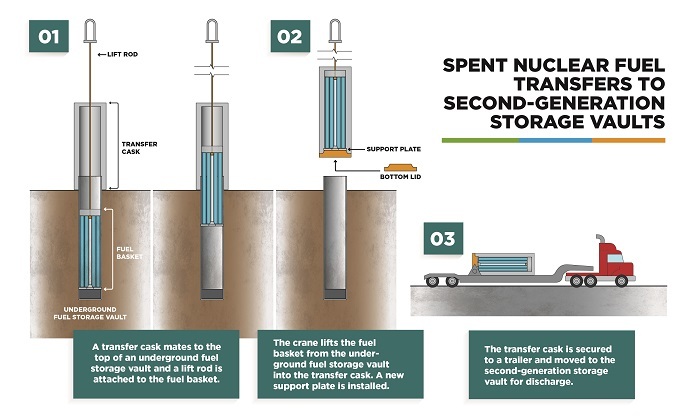 During the removal process, crews open the Peach Bottom first-generation vault and place a transfer cask atop the vault. A crane carefully pulls the fuel basket from the underground vault and moves it into the above-ground transfer cask. After a lid is installed to the bottom of the cask, it is secured to a trailer and moved to the second-generation vault. A similar process is followed to place the fuel basket into the Peach Bottom second-generation vault.
To date, crews at INTEC have transferred 23 fuel canisters to the second-generation vaults and have addressed the concerns over fuel baskets previously considered high risk. Only 17 Peach bottom fuel baskets remain in first-generation vaults, and crews anticipate completing up to 10 transfers this fiscal year ending Sept. 30, with the remaining transfers set for completion in fiscal year 2025. Crews will resume transfers this spring when the weather improves.
“Completing the transfers of the remaining 17 Peach Bottom baskets from the first-generation vaults to the second-generation vaults will be a significant accomplishment in mitigating any further corrosion to the fuel,” INTEC Nuclear Operations Director Ken Brewer said. “This fuel will eventually be placed in a package that is ready for transport and storage in a geological repository. Maintaining the Peach Bottom fuel and container integrity is important for that packaging.”
-Contributor: Carter Harrison
 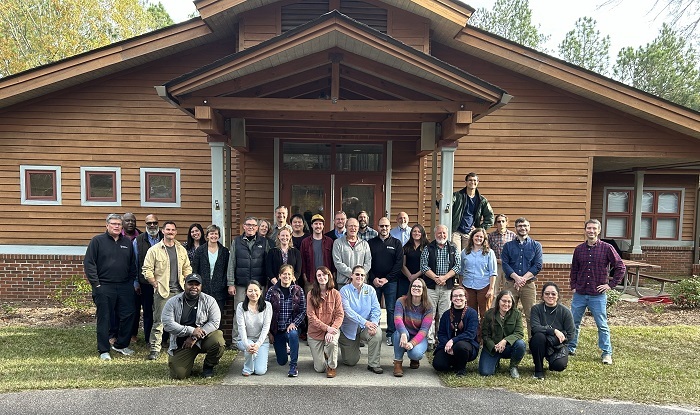 Participants in the University of Georgia Savannah River Ecology Laboratory and U.S. Department of Agriculture Forest Service - Savannah River collaboration conference
gather for a group photo. U.S. Department of Agriculture image
AIKEN, S.C. — Research scientists and graduate students from the University of Georgia’s Savannah River Ecology Laboratory (SREL) and program managers from the U.S. Department of Agriculture Forest Service - Savannah River (USFS-SR) recently gathered to explore efforts to expand collaboration between the two organizations that conduct ecological research and natural resource management on the 310-square-mile Savannah River Site (SRS).
“Our two organizations have long histories working on the SRS and are both heavily involved in the environmental stewardship of the site,” SREL Director Olin “Gene” Rhodes said. “It gives me great pleasure to be involved in working with the management and staff of the USFS-SR to identify how we can collaborate to achieve even more for the public good and find ways to leverage our resources to work together to solve complex natural resource issues on the SRS.”
The history of both groups on the SRS dates to the early 1950s. At that time, the Atomic Energy Commission, a predecessor agency to DOE, invited SREL to conduct a baseline biological inventory on the plants residing on the newly established Savannah River Plant.
The Forest Service was contracted to reforest the newly acquired land. Over the past 70 years, the missions of both teams have expanded and overlapped at times to include a wide range of ecological research and environmental stewardship. A sampling of these efforts includes watershed restoration, wildlife conservation and management, and environmental remediation.
Each organization has a unique role in continuing the legacy of the SRS being designated as the first National Environmental Research Park. Serving as an outdoor laboratory for research to achieve national environmental goals, the park can be used for ecological research, study of the environmental impacts of energy developments, and informing members of the public of environmental and land-use options open to them.
“Working closer with the staff of SREL to share knowledge and resources mutually benefits each of our missions,” said DeVela Clark, SRS forest manager. “It will allow us both to conduct critical environmental research and at the same time implement science based adaptive forest management practices.”
-Contributors: Katrina M. Ford, Joe Orosz
 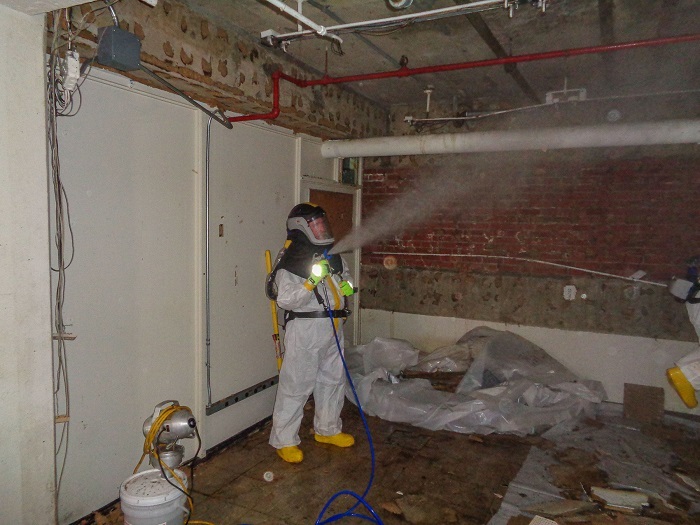 An Oak Ridge worker sprays fixative to support asbestos abatement efforts at the Beta-1 facility at the Y-12 National Security Complex.
OAK RIDGE, Tenn. – EM crews in Oak Ridge have completed major deactivation efforts on a Manhattan Project-era facility at the Y-12 National Security Complex slated for demolition.
The Oak Ridge Office of Environmental Management (OREM) and contractor UCOR have been working toward this deactivation milestone since 2020. Workers finished deactivating the above-ground floors of the Beta-1 facility in December. Now, only deactivation work in the basement remains before the teardown can begin.
Beta-1 is a 210,000-square-foot, two-story building constructed in 1944 to enrich uranium during World War II. It was later converted to laboratory space for fusion-energy technology.
The Beta‐1 Complex includes the Fusion Energy Technology Building, Helium Compressor Building and a steel utility transformer. All three will be demolished together.
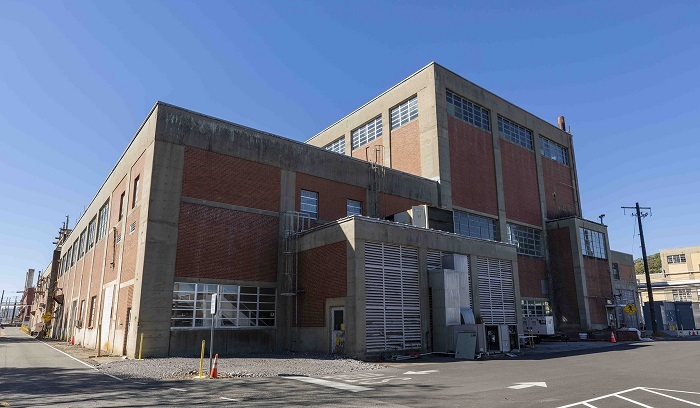 Constructed in 1944, Beta-1 is a former Manhattan Project era enrichment facility at the Y-12 National Security Complex. The Oak Ridge Office of Environmental Management is slated to demolish the 210,000-square-foot facility in 2026.
“Having safely and efficiently removed barriers, completing the building deactivation is a great achievement for our team,” said Billy Lloyd, UCOR project manager.
Workers faced a significant challenge at Beta-1: standing water in the basement due to old, failed sump pumps. To resolve this issue, crews installed a water treatment system and have since treated and removed more than 2 million gallons of water that previously stood in that area. The system filters water to meet stringent water quality standards. Once filtered, the water is treated and discharged.
In addition to ridding the basement of water, crews removed contaminants from the above-ground structure, including asbestos from floor and ceiling tiles and pipes. They also took out more than 100 linear feet of old, brittle thorium-contaminated piping.
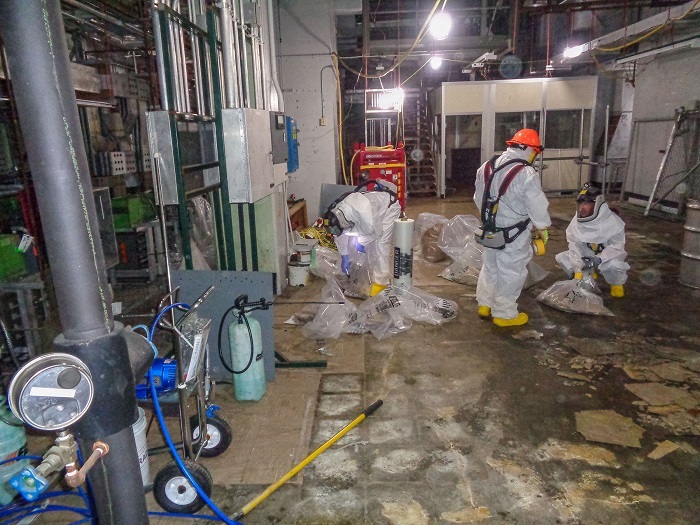 Oak Ridge workers remove asbestos as part of deactivation efforts inside the Beta-1 facility at the Y-12 National Security Complex.
With the above-ground deactivation complete and the basement pumped of water, the final step is to deactivate the basement prior to demolition.
“We continue to make great progress with the water treatment skid in place and are poised for a successful basement cleanup by fall 2024,” said William Lloyd, UCOR project manager.
Demolition of Beta-1 is expected to begin in 2026.
The next major demolition project at Y-12 is Alpha-2, another large Manhattan Project enrichment facility measuring 325,000 square feet, scheduled to begin this summer.
-Contributor: Carol Hendrycks
  Views from the recent grand opening of the Junior Achievement of Georgia Discovery Center of the Central Savannah River Area, where Savannah River National Laboratory hosts a "storefront."
EVANS, Ga. — EM’s Savannah River National Laboratory (SRNL) opened its “storefront” within the Junior Achievement (JA) of Georgia Discovery Center of the Central Savannah River Area (CSRA) in Evans, Georgia, earlier this month.
The center will benefit middle school students in Richmond and Columbia counties in Georgia.
“We’re excited to partner with JA Georgia in the opening of its Discovery Center of the CSRA,” said SRNL Deputy Lab Director Sharon Marra. “Our storefront within the Discovery Center of the CSRA will help motivate, engage and inspire students, equip them with key career-readiness skills, and help them to be financially literate by understanding key business principles.”
EM’s national laboratory is one of 30 organizations participating in the JA Discovery Center of the CSRA. The center’s goal is to provide all children, no matter their background, the opportunity to develop skills to become financially independent and responsible. This center will enable JA of Georgia to reach into the CSRA and provide invaluable experiences for up to 15,000 students per year.
Junior Achievement Discovery Centers blend key components of education to create state-of-the-art learning facilities where students apply concepts they learn in the classroom in a 360-degree, authentic and immersive experience.
At the center, students become part of a simulated version of their hometown within two innovative programs: JA BizTown and JA Finance Park. Students work together with peers and adult volunteers to develop their skills and an understanding of financial concepts while fostering an entrepreneurial spirit.
Battelle Savannah River Alliance, the SRNL management and operations contractor, sponsored the lab’s storefront. There, sixth grade students will interact within a simulated economy and take on the roles of employee, taxpayer and consumer. Students discover the intricacies of being a professional and a member of the community while working a specific role within the laboratory.
As part of the JA Finance Park, seventh graders create and maintain a household budget and have the rare opportunity to experience their personal financial futures firsthand. Every student receives a real- life scenario for which they must manage and consider factors including education, family size and income.
-Contributor: Scott Shaw
 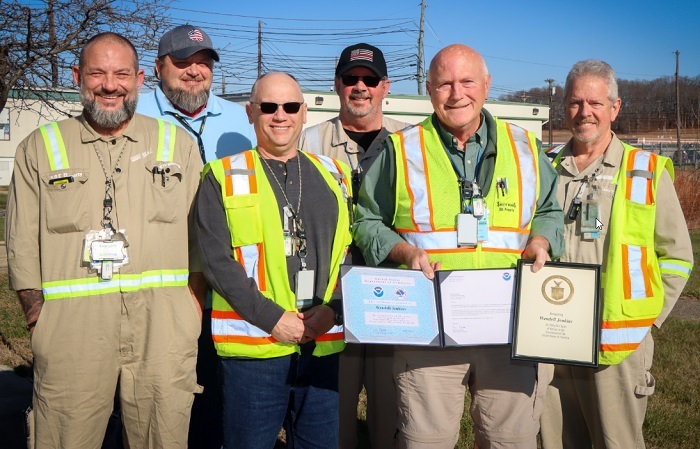 Portsmouth Site Infrastructure and Site Maintenance employees display certificates of appreciation they received for their efforts in the daily collection of data for the National Oceanic and Atmospheric Administration. From left: Donnie Osborne, Jonas Thacker, Todd Kimbler, Doug Davis, Wendell Jenkins and Scott Miller.
PIKE COUNTY, Ohio — National weather agencies recently recognized workers at EM's Portsmouth Site for their contributions to climate science.
The Portsmouth team was recently awarded certificates of appreciation from the National Weather Service (NWS), National Oceanic and Atmospheric Administration (NOAA) and U.S. Department of Commerce for their contributions to NOAA’s mission. Personnel at Portsmouth have provided data to NWS, a division of NOAA.
NOAA’s mission in part is to understand and predict changes in climate, weather, ocean, and coasts, to share that knowledge and information with others, and to conserve and manage coastal and marine ecosystems and resources.
“The observations you provide serve as an integral part of the climate history of the United States,” NWS Meteorologist Thomas Johnstone said in the letter of appreciation to Portsmouth. “Thank you for your dedication and faithful service over so many years.”
For the past 35 years, Portsmouth crews have collected data on river water levels and rainfall measurements from the site’s X-608 Well Field seven days a week.
“Our responsibilities include collecting data, keeping accurate records, as well as being good stewards,” Portsmouth Site Lead Jeremy Davis said. “We’re proud our employees make a difference beyond the Portsmouth Site.”
Fluor-BWXT Portsmouth (FBP) Infrastructure and Site Maintenance Project Support Manager Wendell Jenkins leads the team to support this effort. Although the certificates of appreciation bear his name, Jenkins says the work is a team effort. FBP is EM's decontamination and decommissioning contractor for Portsmouth.
“Each day we log and enter the data into a spreadsheet, and then send in the results,” Jenkins said. “With the presented data, NOAA tracks and trends information to predict flood stages and report historical values. It truly is a collective success.”
-Contributor: Michelle Teeters
  An electrical crew with contractor Hanford Mission Integration Solutions upgrades power lines to improve energy efficiency at the Hanford Site.
RICHLAND, Wash. — Energy conservation efforts at the Hanford Site continue to earn incentives through the Bonneville Power Administration’s (BPA) Energy Efficiency Incentive program.
Incentives are cash rebates for energy saving projects. Contractor Hanford Mission Integration Solutions (HMIS) works with other Hanford contractors for the EM Richland Operations Office and Office of River Protection to identify qualifying projects and submit those to the BPA.
Richland Operations Office Chief Engineer Elaine Porcaro noted the importance of investing in energy saving upgrades.
“As the cleanup mission progresses and Hanford embarks on new, energy-intensive treatment missions, saving energy and accomplishing the mission in the most efficient way possible is key to supporting future cleanup work,” Porcaro said.
The financial incentives earned by each contractor go back into the project or facility budget that made the upgrades, allowing more money to directly fund the cleanup mission and future initiatives.
“Most of the Hanford Site’s incentives in the last two years came from energy-efficient LED lighting and improvements to electrical transmission lines,” HMIS and Hanford Site Energy Manager Christian Seavoy said. “The upgrades earned Hanford contractors $190,679. That is equivalent to 884,902 kilowatt-hours saved — enough energy to power 1,000 homes for a month.”
Hanford Site contractors have earned $1.66 million in incentives since the program began in 2012. Annual energy savings associated with the improvements are approximately 6.8 million kilowatt-hours, enough to power those 1,000 homes for almost eight months.
 |
|
More efficient and brighter LED lights in Hanford Site facilities reduced energy use. |
Upgrading aging infrastructure isn’t the only way for Hanford contractors to earn financial incentives. New construction, such as Hanford’s Central Plateau Water Treatment Facility and offices at its 222-S Laboratory, provides the opportunity for contractors to earn BPA incentives by exceeding energy-efficiency construction requirements.
“The One Hanford team works to ensure every aspect of the mission is as efficient as possible, to stretch available funding and maximize cleanup progress,” said Porcaro. “Efficiency projects like these are principal in optimizing site energy usage and they provide triple dividends: they reduce the cost of power and power infrastructure expansion, and pay direct incentives, which increases funding available to support the primary cleanup mission. Optimizing site energy usage will help Hanford progress our vital cleanup mission.”
Porcaro added, "Congrats to our Hanford contractors on teaming to achieve these impressive incentives year after year.”
-Contributor: Jill Harvill
|




